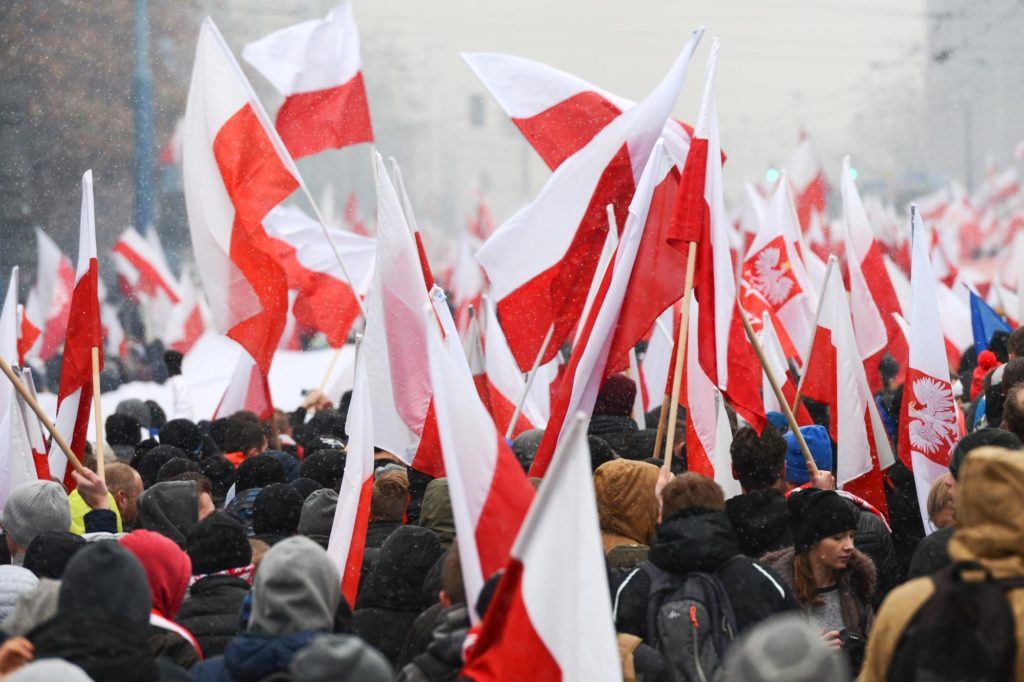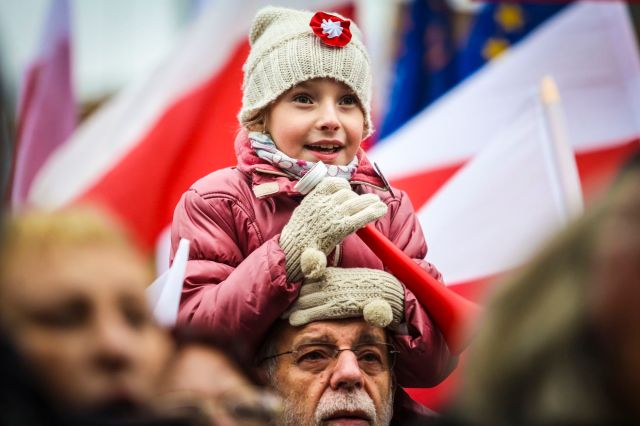Divided Poland celebrates National Independence Day, 2016. Credit: Beata Zawrzel/SIPA USA/PA Images

I have often thought, and written, that coverage of Poland in the Western media is disproportionately negative – for all of its controversies, the nation is, among other things an undeniable economic success story. It has doubled its GDP since 1990, and its economy is still growing. Foreign investment has swelled in strength and with safe, thriving and historic cities like Krakow, Warsaw and Gdansk it has become a very popular tourist destination.[1. My hometown is not as well-known as these great metropolises but with our historic silver mines becoming a UNESCO World Heritage site we too have benefited from an increase in visitors.]
As with most Western democracies, however, the fruits of success are not apportioned equally. Some places, and some people, have done better than others. The success of the Law and Justice (PiS) party in Poland’s 2015 elections had a lot to do with voters’ frustration with the Civic Platform (PO) government’s perceived complacence in improving the communities and lives of those left behind. This, combined with cultural change, is producing an increasingly divided Poland.
The most famous conception of Poland’s sociocultural divides is “Poland A” and “Poland B”, with the former being richer and more metropolitan and the latter being poorer and less developed. Geographically, “Poland A” is traditionally described as being to the west of the Vistula (and including Warsaw and Kraków as well as Łódź and Wrocław) and “Poland B” to its east (including Lublin and Białystok as well as much of Poland’s agricultural land).
There is some truth to the divide between the west and east. Historically Poland was divided, literally – between Prussia, Russia and Austria. “Prussian” Poland, which now makes up much of Poland A was industrially powerful while “Austrian” and “Russian” Poland, which now make up much of Poland B, were poorer and less developed. Infrastructure – which now includes roads, airports and Internet access – has remained stronger in the west, cities in the west attract greater investment than those in the east.[2. Grzegorz Węcławowicz, ‘Urban Development in Poland, from the Socialist City to the Post-Socialist and Neoliberal City’, 2016]
The divide has also been reflected in voting patterns. The more socially and economically liberal party, PO, dominated in the west in the 2007 elections while the socially conservative and economically populist PiS dominated in the east.
Yet, it would be wrong to think of Poland in these sweeping binary terms. Ideas of the richer west versus the poorer east are compromised by the existence of struggling regions like Warmian-Masuria in Poland A and thriving cities like Rzeszów and Lublin in Poland B. Nor is Poland A uniformly liberal – PiS made significant inroads into the west during their triumphant 2016 election campaign.
While Poland A and Poland B retain some conceptual power, the starkest class and cultural divides in Poland are now between the rich and relatively cosmopolitan major metropolises, which have enjoyed the fruits of a globalised economy, and the poorer rural areas and smaller towns and cities which have struggled to replace declining industries and trade.
It is this that has led to rural Poland being described as “the second Poland” and “the different Poland”, characterised by poverty and cultural conservatism. PiS are most popular here, winning more than half the vote with promises of economic redistribution and traditionalist Catholic principles. Despite government and European Union investment, economic improvements have been “temporary and fragmentary.”[2. Dariusz Żmija, ‘Economic Poverty in Rural Areas of Poland’, 2015] Jobs are still in short supply and education is still lacking inadequate.
But it is not just rural communities that are being left behind, urban areas are at risk as well. I live in the Katowice Urban Area: a group of towns and cities that make up one of the most populated regions in Poland. A bus ride through the area reveals serious inequalities. Katowice is thriving, with its mines and steelworks, and national and international businesses, yet smaller cities suffer from what Dr Robert Krzysztofik has called “multiple and overlapping problems: economic, demographic, social, infrastructural and spatial.” Jobs and people have disappeared, leaving these cities struggling to fulfil their human, cultural and economic potential.
New developments have brought new opportunities, such as the construction of a giant shopping and entertainment centre in nearby Bytom, but investment alone is not enough. For rural and provincial Poland to thrive – as Henry Olsen points out in relation to Pennsylvania’s Levittown – meaningful development cannot be achieved top-down. Local people, businesses and institutions must be given the power to reform their communities according to themselves.

In the future there will be new divides, between Poles raised after communism and before communism. The UK has seen a rift between left-leaning and remain-voting millennials and their far more conservative and Brexit-sympathetic elders. Poland is unlikely to have a clear political divide, but it is on course to have a generational one.
Poland has one of the lowest birth rates in Europe, and an ageing population. Young Poles, still struggling with some of the higher youth unemployment and youth poverty rates in Europe, will face steep social care costs in the future.
Also like the UK – and other advanced economies – many young people are struggling financially. But there is also a clear cultural divide. Poles who lived under communism had access to Western culture, as well as their own art and entertainment, but Poles who were raised after communism have been saturated with Western music, television, cinema and social media.
These engines of secular individualism have had a mixed effect on generational opinion. Young Poles attend church in lesser numbers than their parents and have more liberal opinions on matters of personal choice. On the other hand, they still oppose abortion on demand and are hostile to non-European immigration. It remains to be seen how these opinions will evolve, but one effect that Western media has undeniably had is to make emigration even more attractive.
Youthful dissatisfaction with “traditional” politics was reflected in the fact that more than half of Poles between the ages of 18 and 26 voted for outsider candidates: the maverick rock star Paweł Kukiz, the eccentric Eurosceptic Janusz Korwin-Miike and the struggling parties of the Left. Differing opinions on social and economic matters are unlikely to make young Poles a coherent voting bloc but their animating concerns of self-interest are likely to disrupt Poland’s social and political life if they are not given a real stake in the nation’s future in terms of jobs, homes and the potential to start families.
Poles are patriotic people and despite their political disagreements, as fierce as they are, they have maintained a remarkably stable and cohesive nation. But as new divides take hold – between the haves and the have nots, and between the young and the old – there is no place for complacency.










Join the discussion
Join like minded readers that support our journalism by becoming a paid subscriber
To join the discussion in the comments, become a paid subscriber.
Join like minded readers that support our journalism, read unlimited articles and enjoy other subscriber-only benefits.
Subscribe